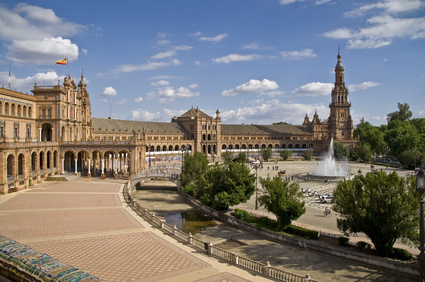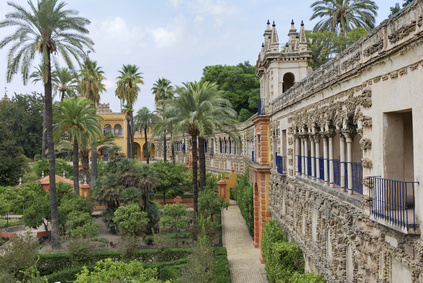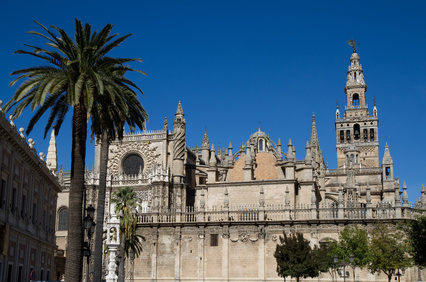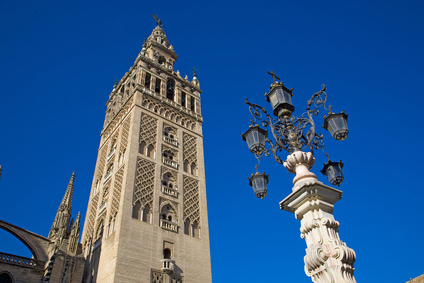Seville is the capital of the Autonomous Region of Andalusia and the fourth largest city in Spain after Madrid, Barcelona and Valencia with about 750,000 inhabitants. Situated on the river Guadalquivir (the name comes from Arabic), Seville has been a colourful, lively city for many centuries and a melting pot of many cultures. Seville is known for its bullfighting and flamenco, the world-famous “national dance” of Andalusia. Seville is a place with a great history that goes back more than two thousand years. Among others, the Middle Ages, the Renaissance and also the Arab period were important epochs of the city’s history. In 1992 the modern Sevilla was the proud host of the World Exposition Expo.
Guided Sightseeing SevilleThe most important sights in Seville are undoubtedly the Alcázar Palace and the well-known Cathedral. We recommend a guided tour of both buildings. The following on the Internet on the well-known website Getyourguide bookable tours we recommend: 1. Good guidance Alcazar: More info and booking 2. Good Guide Seville Cathedral: More info and booking 3. Combined tour of both buildings: More information and booking |
 Picture: © globetrotter – Fotolia.com
Picture: © globetrotter – Fotolia.com
Parking Seville: Finding a parking space in the city of Seville is very difficult. As a tourist, it is best to book a parking space online in advance in a public or private car park. There is a great website for this, also in German: Click here
Seville Sightseeing 2025
Seville hosts buildings with great architecture. The Alcazar Palace from the 10th century should not be missed. The gardens of the Alcazar Palace are another important sight and an oasis of peace in the otherwise hectic city. The ponds, fountains and the Moorish blue tiles with interesting patterns, which are unusual for Central Europeans, are some of the highlights of the garden in Seville.
The district of San Marco, the heart of Venice.
Our tip: Horse farm Yeguada de la Cartuja near Jerez: Very interesting tour of the stud with the famous horses from Andalusia Carthusian horses. You can see a show, adult horses and young babies (foals). Hardly any tour is southern Spain has better reviews from participants: >>> More information and booking
 Picture: © Gratien Jonxis – Fotolia.com
Picture: © Gratien Jonxis – Fotolia.com
Guided Sightseeing SevilleThe most important sights in Seville are undoubtedly the Alcázar Palace and the well-known Cathedral. We recommend a guided tour of both buildings. The following on the Internet on the well-known website Getyourguide bookable tours we recommend: 1. Good guidance Alcazar: More info and booking 2. Good Guide Seville Cathedral: More info and booking 3. Combined tour of both buildings: More information and booking |
One of the most important sights of Seville is certainly the Gothic cathedral of the city called Santa Maria de la Sede, the construction of which began in the 15th century. It is one of the largest churches on earth and a UNESCO World Heritage Site. The highlight for many tourists in the church is the tomb of Christopher Columbus, the most famous seafarer in world history.Tickets can be bought in advance, the queues at the church are often very long. The tickets are available on this website.
 Picture: © Circumnavigation – Fotolia.com
Picture: © Circumnavigation – Fotolia.com
The Giralda tower is remarkable, which first served as the minaret tower of a mosque and was later converted into a Christian church tower. The Giralda Tower, over 100 metres high, can be climbed – from nowhere else you have a better view of Seville.
 Picture: © JONATHAN – Fotolia.com
Picture: © JONATHAN – Fotolia.com
Seville is famous and notorious for its nightlife. There is often more going on in the streets at midnight than during the day. If one wants to see performances of flamenco dancers, one is right in the district Santa Cruz, the old Jewish quarter. Many locals spend the warm nights of Sevilla in the bars of the old town or they simply celebrate thousands of times on the street.
Probably the best flamenco show in Seville, which is very popular with tourists, is in the 500-year-old house “Casa de la Memoria”. You have to book this show online beforehand, a great cultural experience and our tip for Seville: >>> Link to the booking page
If you can choose, you should visit Seville in spring. At Easter and in April, Seville hosts large street festivals that revive the city’s rich ancient culture. Fans of flamenco and flamenco costumes in particular should definitely visit Seville during the April festival. Seville is the Spain known for the best tapas (traditional snacks) in the country. The city is also famous for desserts.
Good & Cheap Restaurants in Seville (with Address & Location)
Seville is full of small tapas bars, hidden courtyards, and classic bodegas. If you want to eat well, you don’t have to spend a lot of money here – especially if you know where to go. Here are a few tips:
Bodega Santa Cruz (Las Columnas)
Calle Rodrigo Caro 1, right next to the cathedral
Iconic tapas bar in the heart of the old town. High tables, paper tablecloths, good prices – tourists and locals meet here for a few “montaditos” (mini rolls) or spinach with chickpeas.
El Rinconcillo
Calle Gerona 40, near Metropol Parasol
Seville’s oldest bar (since 1670!) with a rustic flair and traditional cuisine. Particularly delicious: Jamón Ibérico and the meatballs in tomato sauce.
La Azotea
Calle Jesús del Gran Poder 31, near Alameda de Hércules
A bit more modern, but with Andalusian roots. Creative tapas like tuna tartare or grilled octopus. Ideal for a leisurely dinner.
Bar Alfalfa
Calle Candilejo 1, Old Town (Alfalfa District)
Small, cozy bar with many vegetarian options. The goat cheese tortilla and the tomato bruschetta are particularly popular.
Eslava
Calle Eslava 3, San Lorenzo District
Very popular with locals. Small, high-quality dishes, but affordable. It’s best to arrive early – it fills up quickly.
Pages about Andalusia on Spain-Travelinfos.de
| Sevilla – Hauptstadt Andalusiens, bekannt für Alcázar und Kathedrale | Hier klicken |
| Granada – Heimat der Alhambra und Blick auf die Sierra Nevada | Hier klicken |
| Alhambra – Maurischer Palastkomplex und UNESCO-Welterbe | Hier klicken |
| Málaga – Lebendige Küstenstadt mit Museen und Hafenpromenade | Hier klicken |
| Malaga Flughafen – Wichtigster Flughafen der Costa del Sol | Hier klicken |
| Plaza Mayor – Großes Einkaufszentrum nahe dem Flughafen Málaga | Hier klicken |
| Nerja – Hübscher Ferienort mit Stränden und berühmter Tropfsteinhöhle | Hier klicken |
| Torre del Mar – Familienfreundlicher Badeort östlich von Málaga | Hier klicken |
| Torremolinos – Früher Hotspot, heute familienfreundlich und zentral | Hier klicken |
| Carihuela – Stadtteil von Torremolinos, bekannt für Fischrestaurants | Hier klicken |
| Benalmadena – Freizeitangebote, Seilbahn, Marina und Strände | Hier klicken |
| Marbella – Exklusiver Urlaubsort mit malerischer Altstadt | Hier klicken |
| Puerto Banús – Nobel-Yachthafen mit Luxusgeschäften und Nachtleben | Hier klicken |
| Fuengirola – Beliebter Badeort mit Tierpark und langem Strand | Hier klicken |
| Fuengirola Zoo – Moderne Tieranlage mitten in der Stadt | Hier klicken |
| Estepona – Ruhigerer Küstenort mit Blumen und Altstadtflair | Hier klicken |
| Ronda – Beeindruckend auf einer Schlucht gelegene historische Stadt | Hier klicken |
| Jerez de la Frontera – Heimat des Sherry und der Pferdeshows | Hier klicken |
| El Puerto de Santa Maria – Sherry, Strände und Fähre nach Cádiz | Hier klicken |
| Cádiz – Historische Stadt auf einer Halbinsel mit Altstadt und Promenade | Hier klicken |
| Almuñécar – Urlaubsort an der Costa Tropical mit Burg und Strand | Hier klicken |
Top 10 things to do in Seville in 2025
Seville is a city in southern Spain and the capital of the Andalusia region. It is a vibrant and historic city, rich in culture, art and history. Here are the 10 best things to do in Seville.
Seville Cathedral:
Seville Cathedral is the largest Gothic cathedral in the world and a must-see when visiting Seville. The cathedral houses the tomb of Christopher Columbus and features exceptional architecture. Good tour Seville Cathedral: More info and booking
Alcazar of Seville:
The Alcazar is a royal palace built in the 14th century. The palace is a masterpiece of Mudejar architecture and is a UNESCO World Heritage Site. More info and booking
Plaza de Espana:
The Plaza de España is a large public square built for the 1929 Ibero-American Exposition. The square is surrounded by beautiful buildings and features a large fountain and a canal for small boats to navigate.
Maria Luisa Park:
Maria Luisa Park is a beautiful park near Plaza de España. The park is full of fountains, monuments and gardens and is a great place to relax and enjoy nature.
Metropolis Parasol:
The Metropol Parasol is a modern building constructed in 2011 in the center of Seville. The building is made of wood and has a terrace on the second floor with a panoramic view of the city.
Near Santa Cruz:
Barrio Santa Cruz is Seville’s old Jewish quarter with its narrow streets, hidden courtyards and charming squares. The neighborhood is an ideal place to get lost and explore the city.
Flamenco show:
Seville is known as the birthplace of flamenco and visitors can enjoy authentic flamenco shows at many venues around the city. Triana district:
Located across the Guadalquivir River from the city center, the Triana district is full of colorful streets and bustling markets. It is also known for its pottery and ceramics shops.
Museums:
There are many museums to visit in Seville, including museums, archaeological museums and flamenco dance museums.
To eat and drink:
Seville is known for its delicious food and drinks such as tapas, paella and sangria. Visitors should definitely try the local specialties during their stay in the city.
Seville Cathedral
Seville Cathedral, also known as the Cathedral of Saint Mary of the Sea, is a massive Roman Catholic cathedral in the heart of Seville, Spain. It is one of the largest Gothic cathedrals in the world and is a UNESCO World Heritage Site. The cathedral is also the final resting place of Christopher Columbus.
History Seville Cathedral: Good Tour Seville Cathedral: More info and booking
Construction of Seville Cathedral began in 1401 on the site of the city’s former mosque. The mosque was built during Spain’s Islamic period and was one of the largest mosques in the world at the time. After Seville was conquered by Christian troops in the 13th century, the mosque was converted into a church. However, by the 14th century the church had fallen into disrepair and it was decided to build a new cathedral on the site.
The architects who designed the cathedral incorporated elements of mosque architecture into their plans. For example, the cathedral’s bell tower, called La Giralda, was originally the minaret of the mosque. The construction of the cathedral spanned several centuries and was not completed until the early 16th century.
Architecture Seville Cathedral:
Seville Cathedral is a stunning example of Gothic architecture. Its nave is 42 meters high and 18 meters wide, making it one of the largest Gothic naves in the world. With a total area of 11,520 square meters, the Cathedral is the third largest church in the world after St. Peter’s Basilica in Rome and the Basilica of the National Shrine of Our Lady of Aparecida in Brazil.
One of the most striking features of Seville Cathedral is the altarpiece in the main chapel. The altarpiece was created by Flemish artist Pieter Dancart in the early 16th century and is considered one of the finest examples of Renaissance art in Spain. It depicts scenes from the life of Christ and the Virgin Mary.
Another notable feature of the cathedral is the tomb of Christopher Columbus. The tomb is located in the center of the cathedral and is supported by four allegorical figures representing the kingdoms of Castile, Leon, Aragon and Navarre. The tomb was built in the 1890s to commemorate the 400th anniversary of Columbus’ discovery of America.
La Giralda bell tower:
La Giralda is the bell tower of Seville Cathedral and one of Seville’s most recognizable landmarks. The tower is 104 meters high and was originally built as the minaret of the mosque that stood on the site before the cathedral was built. The tower was converted into a bell tower in the 16th century.
What makes La Giralda special is that it has ramps instead of stairs. The ramps were built so that the muezzin, who was in charge of the call to prayer in the mosque, could ride his horse to the top of the tower. Today, visitors can climb the ramps to the top of the tower and enjoy panoramic views of Seville.
Seville Cathedral is a great example of Gothic architecture and one of Seville’s most important landmarks.
Good tour Seville Cathedral: More info and booking
Alcazar Seville
The Alcázar of Seville is an impressive royal palace in the heart of Seville, Spain. It is one of the city’s most visited attractions and is a UNESCO World Heritage Site. The palace is known for its beautiful architecture, intricate tile work and lush gardens.
Story
The Alcázar of Seville was built by Moorish Muslim rulers in the 14th century. Built on the site of an earlier Moorish fortress, the palace has been expanded and modified by subsequent rulers over the centuries. After the Reconquista, the palace was taken over by Christian rulers who continued to remodel and expand it.
Good tour Alcazar: More info and booking
architecture
The architecture of the Alcázar of Seville is a mixture of Moorish and Christian styles. The palace features intricate tilework, ornate arches, and beautiful courtyards. One of the most striking features of the palace is the Patio de las Doncellas (Patio of the Maidens), a beautiful courtyard with a reflecting pool in the centre. The courtyard is surrounded by arcades and has beautiful tiling on the walls.
The palace also houses the Salon de los Embajadores (Ambassadors’ Hall), a large reception hall with a beautiful dome and intricate tile work. The hall was used by the Christian kings of Spain to receive foreign ambassadors.
gardens
The Alcázar of Seville is surrounded by beautiful gardens that are a mix of Moorish and Renaissance styles. The gardens feature fountains, ponds and beautiful plantings. One of the most impressive features of the gardens is the hedge maze, which is very popular with visitors of all ages.
One of the palace’s most popular gardens is the Jardín de la Danza (Garden of Dance), which includes a large pond and beautiful pavilions. Another popular garden is the Jardín de las Damas (Garden of the Ladies) with a beautiful fountain and ornate tiles on the walls.
Good tour Alcazar: More info and booking
Approach Seville
The almost 500 kilometre long new Madrid line (opened in 1992) was the first high-speed railway line in Spain. Even today, passengers are refunded the full fare if trains up to 300 km/h are more than 5 minutes late. Today it is possible to continue with the super trains to Barcelona, at the latest from the end of 2012 also to Paris (current note: the line is now in operation). Then you can travel on high-speed trains from Cologne or Frankfurt (with changing trains) to Seville in one day.
The large San Pablo airport is located about 10 km north of downtown Seville. In the city there is a subway line, trams and many public buses.
Parking Seville and reserve parking space
If you are travelling in Spain by car or rental car, you know the problem. Parking spaces are difficult to find and expensive in Spanish cities. Multi-storey car parks and public parking lots are very often full. On this great website you can reserve parking spaces in Seville before your arrival.
Guided Sightseeing Seville
The most important sights in Seville are undoubtedly the Alcázar Palace and the well-known Cathedral. We recommend a guided tour of both buildings. The following on the Internet on the well-known website Getyourguide bookable tours we recommend:
1. Good guidance Alcazar: More info and booking
2. Good Guide Seville Cathedral: More info and booking
3. Combined tour of both buildings: More information and booking
One of the most important sights in Seville is without a doubt the city’s Gothic cathedral, Santa Maria de la Sede, whose construction began in the 15th century. It is one of the largest church buildings on earth and is a UNESCO World Heritage Site. The highlight for many tourists in the church is the tomb of the most famous seafarer in world history, Christopher Columbus. Tickets can be bought in advance, the queues at the church are often very long. The tickets are available on this German-language website.
Climate and travel time Seville
Caution: Seville is one of the warmest cities in Europe. The climate is extremely hot, especially in summer. Daytime temperatures of over 35 degrees are the rule in midsummer, the 40 degree mark is also exceeded almost every summer several times. If possible, one should look at the many great sightseeings of Sevilla in spring or autumn. Also in winter, the thermometer in Sevilla rises on the majority of days over 15 degrees, not seldom over 20 degrees. Those who do not want to combine the city sightseeing of Seville with a bathing holiday can also visit the most important metropolis of southern Spain in winter. Then, there are also the least tourists and the hotels are the cheapest. During the spring festivals, the visit is certainly the most impressive, but one should book an accommodation in time.